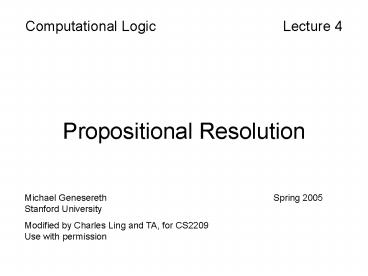Propositional Resolution - PowerPoint PPT Presentation
1 / 27
Title:
Propositional Resolution
Description:
Negations In: Conversion to Clausal Form (or CNF) 8. Conversion ... together with the negated goal (also in clausal form), and try to derive the empty clause. ... – PowerPoint PPT presentation
Number of Views:89
Avg rating:3.0/5.0
Title: Propositional Resolution
1
Propositional Resolution
Computational Logic Lecture 4
Michael Genesereth Spring
2005Stanford University Modified by Charles
Ling and TA, for CS2209Use with permission
2
Axiom Schema Instances
Proofs may be short, but many alternatives to
consider.
3
Propositional Resolution
Propositional resolution is a rule of
inference. Using propositional resolution alone
(without other rules of inference), it is
possible to build a theorem prover that is sound
and complete for all of Propositional Logic. The
search space using propositional resolution is
much smaller than for Modus Ponens and the
Standard Axiom Schemata.
4
Clausal Form
Propositional resolution works only on
expressions in clausal form. Fortunately, it is
possible to convert any set of propositional
calculus sentences into an equivalent set of
sentences in clausal form.
5
Clausal Form
A literal is either an atomic sentence or a
negation of an atomic sentence. P P A clausal
sentence is either a literal or a disjunction of
literals. P P P? Q A clause is a set of
literals. P P P,Q
6
Empty Sets
The empty clause is unsatisfiable. Why? It is
equivalent to an empty disjunction.
7
Conversion to Clausal Form (or CNF)
Implications Out Negations In
8
Conversion to Clausal Form
Distribution Operators Out
9
Example
10
Example
11
Resolution Principle
General Example
12
Issues
Collapse Singletons
13
Issues
Multiple Conclusions Single Application
Only Wrong!!
14
Special Cases
Modus Ponens Modus Tolens
Chaining
15
Incompleteness?
Propositional Resolution is not generatively
complete. We cannot generate
using propositional resolution. There are no
premises. Consequently, there are no conclusions.
16
Answer
This apparent problem disappears if we take the
clausal form of the premises (if any) together
with the negated goal (also in clausal form), and
try to derive the empty clause. General Method
To determine whether a set ? of sentences
logically entails a sentence ?, rewrite ? ?
in clausal form and try to derive the empty
clause using the resolution rule of inference.
17
Example
18
Example
If Mary loves Pat, then Mary loves Quincy. If it
is Monday, Mary loves Pat or Quincy. Prove that,
if it is Monday, then Mary loves Quincy.
19
Example
Heads you win. Tails I lose. Show that you
always win.
20
Soundness and Completeness
A sentence is provable from a set of sentences by
propositional resolution if and only if there is
a derivation of the empty clause from the clausal
form of ? ?. Theorem Propositional
Resolution is sound and complete, i.e. ? ? if
and only if ? - ?.
21
Two Finger Method
22
Two Finger Method
23
TFM With Identical Clause Elimination
24
TFM With ICE, Complement Detection
25
Termination
Theorem There is a resolution derivation of a
conclusion from a set of premises if and only if
there is a derivation using the two finger
method. Theorem Propositional resolution using
the two-finger method always terminates. Proof
There are only finitely many clauses that can be
constructed from a finite set of logical
constants.
26
Decidability of Propositional Entailment
Propositional resolution is a decision procedure
for Propositional Logic. Logical entailment
for Propositional Logic is decidable. Sadly,
the problem in general is NP-complete.
27
Horn Clauses and Horn Chains
A Horn clause is a clause containing at most one
positive literal. Example R, P, Q Example
P, Q, R Example ?P? Non-Example Q, R,
P NB Every Horn clause can be written as a
rule. P, Q, R ? P Q ? R
28
Complexity
Good news When a set of propositional sentences
is Horn, satisfiability and, consequently,
logical entailment can be decided in time linear
in the size of the sentence set. P Q ? R R?
S S? T S ? V Does P, Q V?































